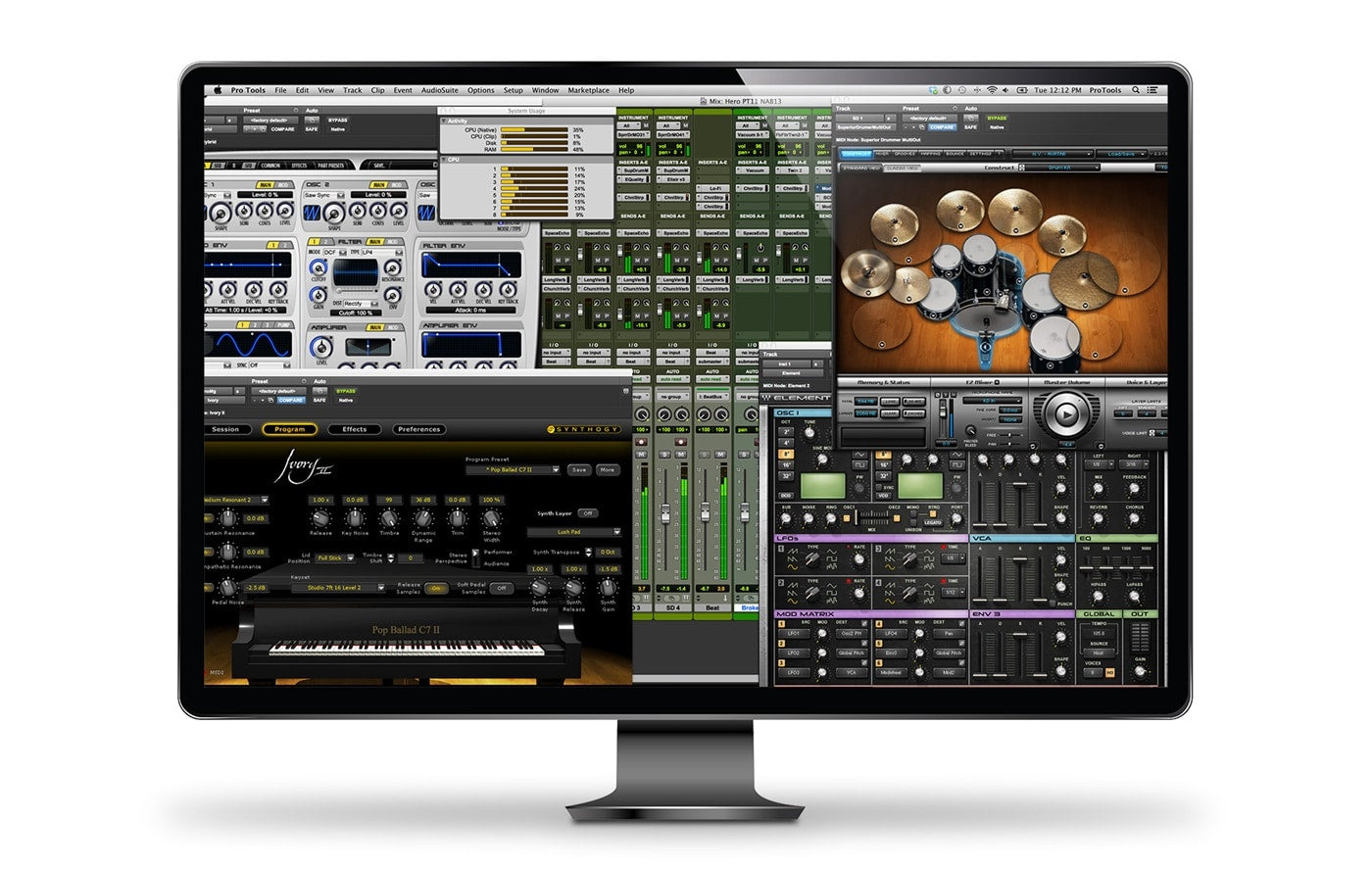
· By John Doe
10 must-have music gears for your home studio
Producing music at home or while traveling has become quite easy. The technology reduces equipment at a minimum level, but you must have minimum equipment to make good tracks. Here is a list of 10 music gears you have to put in your home studio.
1. Choose a workstation
Dedicated machines
Some musicians like machines dedicated to make music: mobile studios or other direct-to-disc studios with a lot of buttons and hierarchical menus. Usage is immediate (just turn on the beast) and “a priori” this kind of machine has little chance of breaking down.
While some have now extensions with screen and mouse, the editing capabilities are limited in . For rappers who like to record in “one shot” and experienced musicians, this may be the most compact solution. Consider that some limitations are also related to the physical hardware: channels and effects number, little change (upgrade), inability to install upmarket plug-ins (UAD, SSL etc.) that create professional mix.
A computer
Recommended configuration : Choose a computer with at least an Intel Core 2 Duo 2GHz or an equivalent processor.
- Windows XP sp3 or +
- FireWire slot
- Asus P5W with Intel chipset i975X or higher Mother board
- 1 HDD Sata 2 with 160GB of internal memory + 1 external 500GB disk for music libraries. don’t forget a USB backup disk!
- 3GB of RAM
If possible choose a 2 or 3 screens video board not too powerful! (It will be less noisy).
Tip: Approximately 5 years ago there was an arms race and beatmakers were looking for the fastest processors that stack more and more plug-ins. With Core 2 Duo processor speed is no longer an issue. So you don’t need to take too high-speed (above 3GHz) processors because you’ll have temperature problems and you’ll need to install noisy fans. It is better to multiply heads processor (quad-core etc) rather than increase speed.
2. A sound card
If you have chosen a computer configuration, you’ll need a “music dedicated” sound card. The advantage of music sound card over multimedia ones (Sound Blaster, Realtek etc) is that it’s possible to choose a very low latency (or response time) and thus play live music. So which to choose?
If you are a solo artist or if you produce only “instrument by instrument” an USB sound card is ok.
If you want to record in “live” with 4-6 microphones, you’ll need a more consistent sound card.
For groups with drummer, 12-16 inputs will be required.
In addition, preference will be given to FireWire connectivity that have a more stable transfer speed in real-time (constant bit rate).
3. Microphones
If dynamic microphones like the SM58 are an ideal choice on stage, they will not be suited for a home studio due to low resolution in the treble.
 You will absolutely need a polyvalent condenser microphone with a large diaphragm to record voice, acoustic guitar, flute, strings etc. If a Neuman TLM127 or a C414 remain a sure value, it’s possible to make very good shots with more affordable mics like Rode mics, Audiotechnica mics or little known, but very efficient for a very low price, MXL microphones
You will absolutely need a polyvalent condenser microphone with a large diaphragm to record voice, acoustic guitar, flute, strings etc. If a Neuman TLM127 or a C414 remain a sure value, it’s possible to make very good shots with more affordable mics like Rode mics, Audiotechnica mics or little known, but very efficient for a very low price, MXL microphones. You can also try the Bluebird from Blue Microphones
.
Tip: To record drum:
Bass drum: Beta52 – Snare: Beta56 – toms: SM57 or SM58 – cymbals: pair of SM81
4. A Preamp
Recording can be made without preamp but when we have used a preamp tube, it becomes impossible to live without it! The most demanding musicians will choose an Avalon 737 SP or Manley preamps. Otherwise the Presonus STUDIO CHANNEL preamp includes a Class A lamp + EQ + compression VCA and reveals exceptional performance for its price.
Tip to record your voice shots:
Set the compression ratio at 3.5:1 and made the needle down (gain reduction) to -5 / -10 dB. Boost treble: + 1.5 dB at 3.5 kHz and +3 dB at 8 kHz, your voice channels will be easier to mix.
5. A DAW software
DAW means Digital Audio Workstation. The software references are all very powerful and offer all the editing and mixing functions required for create a project from A to Z. Your skill and experience will make the difference, so do not be afraid to experiment!
Market benchmarks are Cubase 7 / Nuendo, and Pro Loops
. For Mac we can quote Logic Audio and Digital Performer, particularly used by movie industry’s composers for cue and sync functions.

I also have to mentioned FL Studio 10 that is very affordable. It is one of my favorites software to make rap, dubsetp or trap music.
6. A MIDI keyboard or a control surface
A 3 octaves keyboard is usually ok for most applications and can be easily carried on the road. If it is time for you to take revenge on your teacher classic, you’ll be happy to take 88 notes. Opt for a USB model to save an MIDI interface. Options with pad and knobs are very useful to control your virtual instruments.

A “remote control” MIDI mixer allows you to “feel” the faders on your virtual mixer and allows you to work much faster than with only the mouse. The Start and Stop keys and a Jog to move quickly in the project will facilitate your experience.
Robust and very easy to take on stage, the Yamaha 01X includes both a sound card with integrated DSP and a control surface that lets you easily control your software.
7. A mixer
In a digital world, the mixer is no longer the master-key of your home studio, and this is good news for your budget ;)!
Since we mixed using a computer, we will primarily use the mixer for listening. However if you do not have a dedicated preamp mics, you should pay a particular attention to the quality of the integrated mixer mics. That’s why Mackie mixers and Yamaha mixers are very popular.
Reverb: it is very useful for the comfort of the singer when recording. If you choose for a small digital mixer like 01V digital you will be very satisfied with the built-in effects. On the other side with small analog tables, it is better to have an external reverb like Alesis Nanoverb.
8. Headphones
Essential for recordings. they must be “closed” to prevent microphone “transplanted” sounds. I love my Sony MDR7506. For HipHop and Club buffs, Monster Beats by Dr. Dre is a must have.
9. Monitors and source selector
The monitors are the sound engineers greatest tools! Only quality monitors let you really know what you are recording and what you are mixing.

Then I advice you not to skimp on quality! If Genelecs remain a reference, a pair of Mackie HR824 or HR624 will do the job. Still expensive you say? A pair of KRK 4661 with a RP10S subwoofer can still save your mix. If you are not secured with the acoustics of your work environment, take a look at the KRK Ergo that will analyze your room and calibrate your speakers, in addition to his sound card and his listening selector function.
For source selector I use a Mackie Big Knob. A MindPrint Trio will do just as well and has a slice preamp, EQ and compressor for your shots.
10. Studio acoustics gears
Your first enemy is the external environment. In fact, your beautiful large diaphragm microphone is ready to capture every detail of your voice, but also mopeds passing and washing machine of your upstairs neighbor! Try to find a quiet space to work. The sound is carried by air (airborne sound) and walls (structure-borne sound) .

We will try to stop the air by putting seals on doors and windows to stop the airborne sounds. For structure-borne sound (the famous washing machine), it is much harder. Unless taking insulation measures choose a quiet room.
For studio acoustics, try to get a thud. A low ceiling may cause an unpleasant resonance (« flutter echo»). A piece of 8 to 12m ² with fitted carpet will be ideal. Furniture, shelves etc can often stifle current resonances.
Get close a corner of the room and speak loudly. If you hear a lot of bass, it may be that your corners generate standing waves in the bass. Caulk the corners sticking special foam panels (bass trap) or by hacking an angle with wool cloth cover wide-mesh.
Tip: Stick a Colsound ST415 square ceiling above your chair, stick the bass trap CR3030 in the corners and make your records with a SE Electronics Reflexion Filter. Elevate your speakers with foam.

